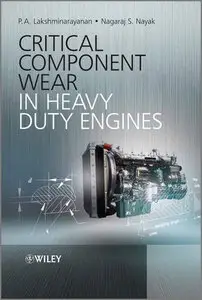Critical Component Wear in Heavy Duty Engines by P. A. Lakshminarayanan and Nagaraj S. Nayak
English | ISBN: 047082882X | 2011 | PDF | 352 pages | 7,4 mb
English | ISBN: 047082882X | 2011 | PDF | 352 pages | 7,4 mb
The critical parts of a heavy duty engine are theoretically designed for infinite life without mechanical fatigue failure. Yet the life of an engine is in reality determined by wear of the critical parts. Even if an engine is designed and built to have normal wear life, abnormal wear takes place either due to special working conditions or increased loading.
Understanding abnormal and normal wear enables the engineer to control the external conditions leading to premature wear, or to design the critical parts that have longer wear life and hence lower costs. The literature on wear phenomenon related to engines is scattered in numerous periodicals and books. For the first time, Lakshminarayanan and Nayak bring the tribological aspects of different critical engine components together in one volume, covering key components like the liner, piston, rings, valve, valve train and bearings, with methods to identify and quantify wear.
The first book to combine solutions to critical component wear in one volume
Presents real world case studies with suitable mathematical models for earth movers, power generators, and sea going vessels
Includes material from researchers at Schaeffer Manufacturing (USA), Tekniker (Spain), Fuchs (Germany), BAM (Germany), Kirloskar Oil Engines Ltd (India) and Tarabusi (Spain)
Wear simulations and calculations included in the appendices
Instructor presentations slides with book figures available from the companion site
Critical Component Wear in Heavy Duty Engines is aimed at postgraduates in automotive engineering, engine design, tribology, combustion and practitioners involved in engine R&D for applications such as commercial vehicles, cars, stationary engines (for generators, pumps, etc.), boats and ships. This book is also a key reference for senior undergraduates looking to move onto advanced study in the above topics, consultants and product mangers in industry, as well as engineers involved in design of furnaces, gas turbines, and rocket combustion.



